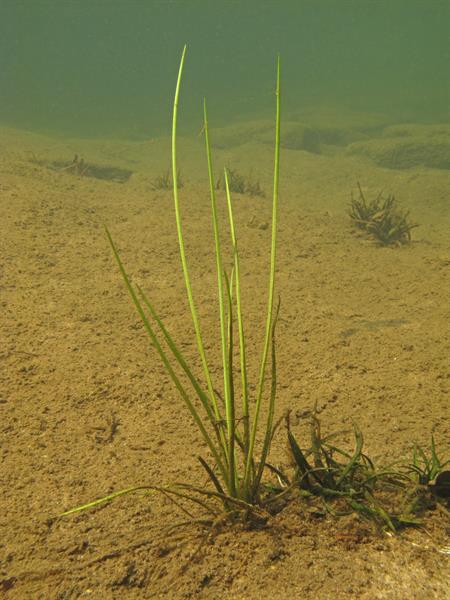
Contributed by P.W. Schafran, L.J. Musselman, and A.S. Weakley
A genus of about 250-300 species, cosmopolitan in distribution. Allopolyploids, derived from crossing between parental species and genome duplication, represent roughly half of the named taxa in eastern North America. Molecular data suggest that many of the southeastern polyploid species contain complexes of morphologically similar but genetically unique taxa. These complexes represent independent polyploidy events between different sets of parental species. The appropriate systematic treatment of these complexes would recognize approximately twice as many species. At present, many polyploid species should be treated only as taxonomic, not evolutionary, entities.
ID notes:Description adapted from Schafran (2019): Isoetes produce sporangia, bearing either megaspores or microspores, that are borne singly in leaf bases. Megaspores are white (gray/black in I. melanospora) and globose; microspores are usually gray or brown and dust-like. Megaspores contain an equatorial ridge (encircling the megaspore) and three radial ridges that extend from the equatorial ridge and connecting at the proximal pole of the megaspore. Some species contain a girdle adjacent to the equatorial ridge; it is considered obscure when this area is textured similarly to the distal portion of the megaspore surface. Perhaps the most distinguishing feature of the megaspore is its surface texture, ranging from tuberculate, echinate, cristate, and reticulate. Microspores are considerably smaller than megaspores, contain a single, longer proximal ridge and two distal parallel ridges at the margins of the curved distal surface. Sporophylls (leaves) emerge from a subterranean, corm-like rootstock and emerge in a spirally or rarely distichously-arranged fashion. Leaf width measurements are at midpoint of the leaf length, well above the flared base. Leaf lengths are of undamaged leaves from leaf tip to the top of the rootstock. Each leaf contains a velum, which is a small flap of tissue between the sporangium and ligule, completely or partially covering the adaxial surface of the sporangium. Use forceps to lift off the membranous, yet durable velum from the sporangium wall.
Key advice:Hybrids are possible between many combinations of species. Hybrids are readily recognized by having megaspores of variable size, shape, and ornamentation (aborted).
Ref: Boom (1982); Bray, Schafran, & Musselman (2018); Brunton (2015); Brunton (2016); Brunton & Britton (1996a); Brunton & Britton (1996b); Brunton & Britton (1997); Brunton & Britton (1998); Brunton & Britton (1999); Brunton & McNeill (2015); Caplen & Werth (2000a); Caplen & Werth (2000b); Hoot, Napier, & Taylor (2004); Jermy In Kramer & Green (1990); Kott & Britton (1983); Luebke & Budke (2003); Musselman (2001); Musselman & Knepper (1994); Musselman et al. (1995); Musselman, Bray, & Knepper (1996); Musselman, Bray, & Knepper (1997); Musselman, Taylor, & Bray (2001); Schafran (2019); Schafran et al. (2016); Schafran et al. (2018); Singhurst et al. (2011); Taylor et al. (1993a) In Flora of North America Editorial Committee (1993b); Wood et al. (2020a). Show full citations.
Hover over a shape, letter, icon, or arrow on the map for definition or see the legend. Data for arrows not developed for genera and families which may have species only occurring outside the flora area.
 © Alan Cressler: Isoetes valida, Lookout Mountain, Chattooga County, Georgia 3 by Alan Cressler | Isoetes valida source | Original Image ⭷
© Alan Cressler: Isoetes valida, Lookout Mountain, Chattooga County, Georgia 3 by Alan Cressler | Isoetes valida source | Original Image ⭷ © Samuel Brinker, some rights reserved (CC BY-NC), uploaded by Samuel Brinker | Isoetes echinospora source | Original Image ⭷
© Samuel Brinker, some rights reserved (CC BY-NC), uploaded by Samuel Brinker | Isoetes echinospora source | Original Image ⭷ © Alan Cressler: Isoetes piedmontana, Cedar Mountain, Douglas County, Georgia 1 by Alan Cressler | Isoetes piedmontana source | Original Image ⭷
© Alan Cressler: Isoetes piedmontana, Cedar Mountain, Douglas County, Georgia 1 by Alan Cressler | Isoetes piedmontana source | Original Image ⭷ © Samuel Brinker, some rights reserved (CC BY-NC), uploaded by Samuel Brinker | Isoetes septentrionalis source
© Samuel Brinker, some rights reserved (CC BY-NC), uploaded by Samuel Brinker | Isoetes septentrionalis source no rights reserved, uploaded by Étienne Lacroix-Carignan | Isoetes septentrionalis source | Original Image ⭷
no rights reserved, uploaded by Étienne Lacroix-Carignan | Isoetes septentrionalis source | Original Image ⭷ © Samuel Brinker, some rights reserved (CC BY-NC), uploaded by Samuel Brinker | Isoetes tuckermanii source | Original Image ⭷
© Samuel Brinker, some rights reserved (CC BY-NC), uploaded by Samuel Brinker | Isoetes tuckermanii source | Original Image ⭷ © Alan Cressler: Isoetes lacustris, Piseco Lake, Little Sand Point State Campground, Adirondack Park, Hamilton County, New York 3 by Alan Cressler | Isoetes lacustris source | Original Image ⭷
© Alan Cressler: Isoetes lacustris, Piseco Lake, Little Sand Point State Campground, Adirondack Park, Hamilton County, New York 3 by Alan Cressler | Isoetes lacustris source | Original Image ⭷ © Samuel Brinker, some rights reserved (CC BY-NC), uploaded by Samuel Brinker | Isoetes septentrionalis source | Original Image ⭷
© Samuel Brinker, some rights reserved (CC BY-NC), uploaded by Samuel Brinker | Isoetes septentrionalis source | Original Image ⭷Feedback
See something wrong or missing on about Isoetes? Let us know here: (Please include your name and email if at all complicated so we can clarify if needed.)
Cite as...